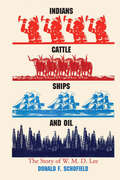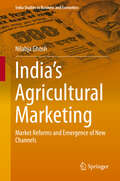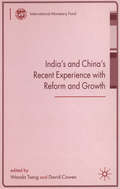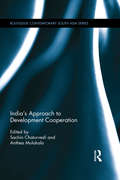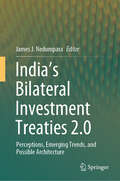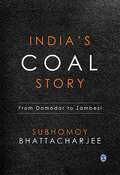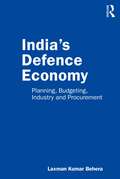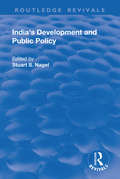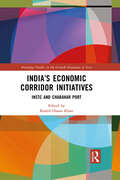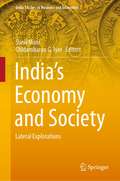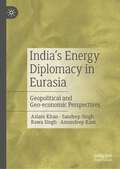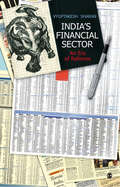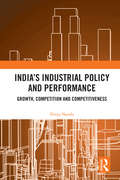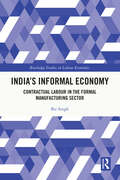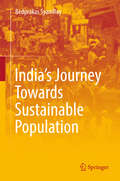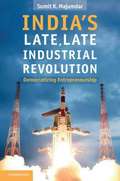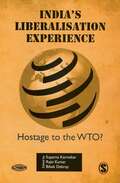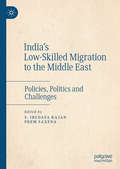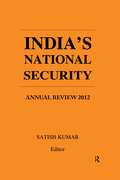- Table View
- List View
Indians, Cattle, Ships, and Oil: The Story of W. M. D. Lee
by Donald F. SchofieldIndian trader, rancher, harbor developer, oil impresario—these are the many worlds of one of the least chronicled but most fascinating characters of the American West. In the early, bustling years of the frontier, a brazen young man named William McDole Lee moved from Wisconsin to Kansas and then to Texas to forge a life for himself. Becoming a driving entrepreneurial force in Texas's development, Lee soon garnered the alliances and resources necessary to shape the financial destinies of disparate groups throughout the state. His story is expertly told in Donald F. Schofield's Indians, Cattle, Ships, and Oil. Beginning in 1869 as a trader to the southern Cheyenne and Arapaho tribes and fort provisioner to troops garrisoned at Camp Supply, Indian Territory, Lee gained a partner and amassed a fortune in short order from trading buffalo hides and robes. Vast herds of buffalo grazing on the southern plains were killed largely on his order. When buffalo were no longer a profitable commodity, Lee tackled his next challenge—the cattle trade. He began with herds branded LR that grazed on pastures near Fort Supply. Then came his LE herd in the Texas Panhandle. Another partnership, with noted cattle rancher Lucien Scott, resulted in the vast LS ranch, one of the most successful operations of its day. Lee even introduced a new breed of cattle, the Aberdeen-Angus, to the western range. But as his partnership faded, Lee moved on to his next undertaking—the development of Texas' first deep-water harbor. In 1888, Lee and other financiers put up one million dollars to finance a dream: opening international trade from the waters of the Gulf of Mexico to the mainland at the mouth of the Brazos River. Their Brazos River Channel and Dock Company was to construct, own, and operate a deep-water harbor at Velasco, with a railroad link to Houston. Though threats of financial disaster loomed large, the Velasco facility was to welcome, in its day, tugs, barges, and three-masted schooners and to provide impetus for Houston's boom. Yet with success, the mercurial Lee turned to yet another challenge—oil. Starting still another partnership, Lee committed himself to prospecting for oil on the West Columbia Ridge in Brazoria County. Lee and crew struck oil in 1907, developing one of the first producing wells of Brazoria County, but inadequate drilling equipment hampered further fruitful exploration. Lee moved his rigs to the famed Spindletop, where he perfected the technique of shallow drilling. Though spectacular success in the oil business eluded him, Lee's accomplishments set him squarely among the great entrepreneurs of the Texas oil industry. Lee's exploits led him to roles in some of the most dramatic moments in Texas and the West—Indian uprisings, buffalo hunts, political scandals, cowboy strikes and shoot-outs, railroad promotions, oil-well blow-outs and gushers. The people he encountered are the famous and infamous of western history: Cheyenne Chief Little Robe and the outlaw "Hurricane Bill" Martin; Indian Agent John D. Miles and Major General John Pope; outlaws Tom Harris and William Bonney, and Sheriff Pat Garrett. Altogether, Lee's biography vividly shows one man's manipulation of people and events during the settlement of the American frontier.
Indians, Cattle, Ships, and Oil: The Story of W. M. D. Lee
by Donald F. SchofieldIndian trader, rancher, harbor developer, oil impresario—these are the many worlds of one of the least chronicled but most fascinating characters of the American West. In the early, bustling years of the frontier, a brazen young man named William McDole Lee moved from Wisconsin to Kansas and then to Texas to forge a life for himself. Becoming a driving entrepreneurial force in Texas's development, Lee soon garnered the alliances and resources necessary to shape the financial destinies of disparate groups throughout the state. His story is expertly told in Donald F. Schofield's Indians, Cattle, Ships, and Oil. Beginning in 1869 as a trader to the southern Cheyenne and Arapaho tribes and fort provisioner to troops garrisoned at Camp Supply, Indian Territory, Lee gained a partner and amassed a fortune in short order from trading buffalo hides and robes. Vast herds of buffalo grazing on the southern plains were killed largely on his order. When buffalo were no longer a profitable commodity, Lee tackled his next challenge—the cattle trade. He began with herds branded LR that grazed on pastures near Fort Supply. Then came his LE herd in the Texas Panhandle. Another partnership, with noted cattle rancher Lucien Scott, resulted in the vast LS ranch, one of the most successful operations of its day. Lee even introduced a new breed of cattle, the Aberdeen-Angus, to the western range. But as his partnership faded, Lee moved on to his next undertaking—the development of Texas' first deep-water harbor. In 1888, Lee and other financiers put up one million dollars to finance a dream: opening international trade from the waters of the Gulf of Mexico to the mainland at the mouth of the Brazos River. Their Brazos River Channel and Dock Company was to construct, own, and operate a deep-water harbor at Velasco, with a railroad link to Houston. Though threats of financial disaster loomed large, the Velasco facility was to welcome, in its day, tugs, barges, and three-masted schooners and to provide impetus for Houston's boom. Yet with success, the mercurial Lee turned to yet another challenge—oil. Starting still another partnership, Lee committed himself to prospecting for oil on the West Columbia Ridge in Brazoria County. Lee and crew struck oil in 1907, developing one of the first producing wells of Brazoria County, but inadequate drilling equipment hampered further fruitful exploration. Lee moved his rigs to the famed Spindletop, where he perfected the technique of shallow drilling. Though spectacular success in the oil business eluded him, Lee's accomplishments set him squarely among the great entrepreneurs of the Texas oil industry. Lee's exploits led him to roles in some of the most dramatic moments in Texas and the West—Indian uprisings, buffalo hunts, political scandals, cowboy strikes and shoot-outs, railroad promotions, oil-well blow-outs and gushers. The people he encountered are the famous and infamous of western history: Cheyenne Chief Little Robe and the outlaw "Hurricane Bill" Martin; Indian Agent John D. Miles and Major General John Pope; outlaws Tom Harris and William Bonney, and Sheriff Pat Garrett. Altogether, Lee's biography vividly shows one man's manipulation of people and events during the settlement of the American frontier.
Indians, Markets, and Rainforests: Theoretical, Comparative, and Quantitative Explorations in the Neotropics
by Ricardo GodoyThis book addresses two important and related questions: does participation in a market economy help or hurt indigenous peoples and how does it affect the conservation of tropical rainforest flora and fauna? Oddly, there have been few quantitative studies that have addressed these issues.Ricardo Godoy's research takes an important step toward rectifying this oversight by investigating five different lowland Amerindian societies of tropical Latin America—all of which are experiencing deep changes as they modernize. Godoy examines the effect of markets on a broad range of areas including health, conservation of flora and fauna, leisure, folk knowledge, reciprocity, and private time preference. He concludes that, contrary to considerable anthropological theory, the effect of markets on the quality of life and the rainforest are often unclear or benign. Godoy uses multivariate techniques to examine the changes modernization has had on many indicators of the quality of life and the environment and concludes that the seeds of socioeconomic differentiation may already lie dormant in simple economies.The impact of modernization on lowland Amerindians is a topic of great concern to anthropologists, researchers, and policymakers in developing nations, and this book is a significant contribution to the debate about the likely future of indigenous people.
India's Agricultural Marketing
by Nilabja GhoshThe proposed book provides an assessment of an important yet controversial policy initiated by the Indian government and governments of several other developing countries. Marketing reforms, it is claimed, can be a crucial answer to solving the problem of rural poverty in agrarian economies where large sections of populace are engaged in low paying agriculture. On a wider front, these reforms could help in providing growth impetus to an economy and even the global economy at large. Yet, the subject of liberalizing agricultural markets is also part of a broad and perhaps a bitter political debate between national and sub-national policy makers and academic discourses in India and other countries. A clearer understanding and a possible resolution of the issues involved will be decidedly useful. The experience of India, one of the largest and most agriculture-dominated economies, will undoubtedly provide valuable lessons not only for steering the domestic economic policy but also for other countries to set their own policy agenda. The book attempts to capture the evolving reality in a large and diverse country and presents an objective evaluation to enable aspiring investors and those in policy making, food business and civil society to make more informed assessment and decision.
India's Amul: Keeping up with the Times
by Namrata Arora Rohit Deshpande Tanya Bijlani Tarun KhannaAmul is an Indian dairy cooperative founded in 1947, eight months before India's independence from British rule, and owned by over three million farmers in the state of Gujarat. It is India's largest food product marketing organization, selling 46 products, including pouched milk, cheese, butter, ice cream and infant food through a million retailers across the country, and is the market leader in almost all the categories that it operates in. Amul is well known among Indian consumers for offering high-quality products at reasonable prices, and runs a highly popular advertising campaign that spoofs current events. It offers its farmers 80% of the consumer's dollar for milk, compared with 35%-40% typical in some Western markets. Amul's cooperative dairy model has been replicated across several Indian states, thereby helping increase the incomes of 80-100 million farmer families across the country. However, despite its success, Amul is beginning to come under increasing pressure. Multinationals like Nestl and Unilever are increasing their presence in India, and competing fiercely with Amul in value-added products like yogurt. The entry of large multi-brand retailers like Walmart and Carrefour in the Indian market threatens to squeeze Amul's margins and undermine its low-cost distribution network. India's large young rural population is shying away from dairy farming in favor of urban jobs, leaving questions about future procurement. Finally, Amul's farmers form a large vote bank in the state of Gujarat, and its cooperative structure risks being compromised by vested political interests. Should Amul continue with the business model that has served it so well for decades, or should it change its strategy in order to keep up with India's changing social, political and economic landscape?
India's Amul: Keeping Up with the Times
by Namrata Arora Rohit Deshpande Tanya Bijlani Tarun KhannaAmul is an Indian dairy cooperative founded in 1947, eight months before India's independence from British rule, and owned by over three million farmers in the state of Gujarat. It is India's largest food product marketing organization, selling 46 products, including pouched milk, cheese, butter, ice cream and infant food through a million retailers across the country, and is the market leader in almost all the categories that it operates in. Amul is well known among Indian consumers for offering high-quality products at reasonable prices, and runs a highly popular advertising campaign that spoofs current events. It offers its farmers 80% of the consumer's dollar for milk, compared with 35%-40% typical in some Western markets. Amul's cooperative dairy model has been replicated across several Indian states, thereby helping increase the incomes of 80-100 million farmer families across the country. However, despite its success, Amul is beginning to come under increasing pressure. Multinationals like Nestl and Unilever are increasing their presence in India, and competing fiercely with Amul in value-added products like yogurt. The entry of large multi-brand retailers like Walmart and Carrefour in the Indian market threatens to squeeze Amul's margins and undermine its low-cost distribution network. India's large young rural population is shying away from dairy farming in favor of urban jobs, leaving questions about future procurement. Finally, Amul's farmers form a large vote bank in the state of Gujarat, and its cooperative structure risks being compromised by vested political interests. Should Amul continue with the business model that has served it so well for decades, or should it change its strategy in order to keep up with India's changing social, political and economic landscape?
India's and China's Recent Experience with Reform and Growth
by Wanda Tseng David CowenChina and India already rank among the world's largest economies, and each is moving rapidly towards the centre stage of the global economy. In this process different priorities have been placed on economic reforms in the past two decades - China taking a more outward strategy and India, until recently, a more inward one. Can they continue to rank among the fastest expanding economies? This volume addresses the issue, highlighting what has worked and what more needs to be done to ensure sustained rapid economic growth and poverty reduction. Addressing the two countries' recent experiences with growth and reform, this book provides important insight for other developing economies.
India’s Approach to Development Cooperation (Routledge Contemporary South Asia Series)
by Sachin Chaturvedi Anthea MulakalaIndia is emerging as a key player in the development cooperation arena, not only because of the increasing volume and reach of its south-south cooperation but more so because of its leadership and advocacy for the development of a distinctly southern development discourse and knowledge generation. This book traces and analyses the evolution of Indian development cooperation. It highlights its significance both to global development and as an effective tool of Indian foreign policy. Focussing on how India has played an important role in supporting development efforts of partner countries in South Asia and beyond through its various initiatives in the realm of development cooperation, the book tracks the evolution, genesis, and the challenges India faces in the current international context. The contributions provide a rich mix of academic and government, policy and practice, Indian and external perspectives. Theory is complemented with empirical research, and case studies on countries and sectors as well as comparisons with other aid providing countries are presented. The book is of interest to researchers and policy makers in the field of development cooperation, the role of emerging powers from the South, international development, foreign policy and global political economy.
India’s Bilateral Investment Treaties 2.0: Perceptions, Emerging Trends, and Possible Architecture
by James J. NedumparaThe book provides a deep and insightful enquiry into a set of persistent questions about investment treaties, including the causal relationship between investment treaties and investment, and their role in emerging economies such as India. It is innovative and pathbreaking as it distils past practices and experiences of investment treaties, from local and global perspectives, and seeks to sketch a template that could mark the next generation of bilateral investment treaties (BITs) for emerging economies, including India. The book provides an authoritative account of whether the investment community accords importance to the existence of investment treaties while taking investment decisions, based on cross-country ethnographic research involving some of the key stakeholders drawn from foreign investor community, academicians, leading practitioners and key policy makers. Among other topics, it discusses potential evolution of investment treaties and how next generation treaties should look like, drawing lessons from past experiences, current practices and most importantly, the outlook for India in its next stage of development. The book is very useful for academic community studying international investment law (IIA). Domestic and international practitioners of law will find the book a must read as the topic is emerging as a vibrant field of practice and consulting, and the volume focuses on some of the most debated areas in IIA. The book contains interest areas for policy makers, especially those who work in the field of commerce and economic diplomacy. It is also immensely useful to treaty negotiators and professionals that actively assist and advise negotiating teams of BITs and other investment disciplines which are part of trade agreements.
India’s Coal Story: From Damodar to Zambezi
by Subhomoy BhattacharjeeBelieve it or not, India has one of the largest coal reserves in Asia, but still relies on imports from Australia and Mozambique... India’s coal reserves were the lifeline that fuelled the British Empire in Asia, and yet today this industry is on the verge of collapse. Coal was at the centre of a major political scandal that nearly sent a prime minister to jail. This one-of-a-kind book unveils the murky politics around coal - the resource that could provide India all the energy security it needs.
India’s Contemporary Macroeconomic Themes: Looking Beyond 2020 (India Studies in Business and Economics)
by D. K. Srivastava K. R. ShanmugamThis book extensively examines various contemporary macroeconomic themes of India, namely growth and macro policies, tax reforms, government finances and intergovernmental fiscal transfers, banking and monetary policy, and environment and social sector policies. It has three to six chapters devoted to each of these broad themes, with the contributors being eminent economists from the region. The book serves as an excellent reference for students in economics, finance, and management, and a valuable tool for professionals such as policymakers and investment analysts and other stakeholders in the areas of global economics and finance, in general, and India in particular.
India’s Defence Economy: Planning, Budgeting, Industry and Procurement
by Laxman Kumar BeheraAs the fourth largest military spender in the world, India has a huge defence economy supported by a budget amounting to nearly $67 billion in 2020–21. This book examines how well India’s defence economy is managed, through a detailed statistical exposition of five key themes – defence planning, expenditure, arms production, procurement and offsets. This book is based on hard-core evidence collected from multiple government and other credible sources including the ministries of Defence, Finance, and Commerce and Industry, Comptroller and Auditor General of India and the Reserve Bank of India. It discusses key issues such as the evolution of India’s defence plan; the feasibility of increasing defence spending; India’s defence acquisition system; and the recent reform measures taken under the rubric of the ‘Make in India’ initiative. Well supplemented with original tables and figures, India’s Defence Economy will be indispensable to students and researchers of defence and security studies, politics and international relations, finance, development studies, economics, strategic studies, South Asian politics, foreign policy and peace studies. It will also be of interest to defence ministry officials, senior armed forces personnel, military attachés, defence training institutes and strategic think tanks.
India's Development and Public Policy (Routledge Revivals)
by Stuart S. NagelThis title was forst published in 2000: An analysis of India’s development and public policy from the perspectives of five major fields of public policy. 1. Economic policy, including public policy toward industrial development. 2. Social policy, including religion, education and women’s rights. 3. Environmental policy, including possible conflict with economic development. 4. Science-technology policy, including agricultural development, information technology and administering the electronics industry. 5. Political reform, including local government and general elections.
India’s Economic Corridor Initiatives: INSTC and Chabahar Port (Routledge Studies in the Growth Economies of Asia)
by Kashif Hasan KhanIndia’s Economic Corridor Initiatives highlights key aspects of current discourses on India’s initiative of the International North-South Transport Corridor (INSTC) and Chabahar, and their geo-economic significance.INSTC was founded by India, Russia, and Iran, and the Chabahar port in Iran provides a major prospective conduit for India's interchange and commerce with West Central Asia while maintaining a strategic distance from Pakistan's entry route. This book analyses the drastic changes in the equation of international relations in general, and more particularly between India and Eurasian countries. Contributors from Iran, Central Asia, Russia, Armenia and Europe provide a wide spectrum of opinion and analysis on the subject. The chapters claim that these corridors provide an alternative to the BRI and can play a pivotal role in de-escalating tensions through negotiations.A new addition to the debate on contemporary dynamics in Eurasia and India, this book will be of interest to researchers studying economic corridors, transnational and trans-regional economic relationships, security studies, regional and area studies, international relations and Indo-Iran-Russia relations.
India’s Economy and Society: Lateral Explorations (India Studies in Business and Economics)
by Sunil Mani Chidambaran G. IyerThis book is a collection of fifteen contributions that undertake a detailed analysis of seven broad dimensions of India’s economy and society. All the contributions approach the problems in their respective areas empirically, while being theoretically informed. The book begins with a section containing detailed and empirically supported chapters on the recent crisis in India’s agricultural sector and the reforms in the agricultural markets. Another section is dedicated to the issue of infrastructure financing, and new ways of financing large infrastructural projects are critically examined. Other sections are related to innovations and technology impacts on industry; international trade; health and education; labor and employment; and the very important issue of gender. The selected discussion topics are both of contemporary importance and expected to remain so for some time. Most of the chapters introduce readers to data in addition to methods of analyzing this data, to arrive at policy-oriented conclusions. The rich collection carries learnings for researchers working on a wide range of topics related to development studies, as well as for policymakers and corporate watchers.
India's Emerging Financial Market: A Flow of Funds Model (Routledge Studies in the Growth Economies of Asia #Vol. 77)
by Tomoe MooreIn the early 1990s, financial liberalization started in India, and it was thought that such reforms would increase economic growth. This argument formed part of the finance led industrialization hypothesis and although higher growth resulted, higher industrialization did not immediately. This book is the first study to comprehensively apply the flow of funds model for India. Using detailed data of the Indian economy, the whole financial sector is presented with associated policy simulation for India. The demand function is theoretically grounded in the Almost Ideal Demand System and cointegration techniques are adapted into the econometric methodology. The policy simulation experiments are conducted with a view to analyzing the delivery of loanable funds to sectors which are the most in need of poverty-reducing economic growth. The system-wide simulation as a result of interactions with disaggregated economic sectors will allow the analysis of a wide spectrum of policy effects on issues such as the determinant of interest rates, financial capital formulation, and the role of financial institutions, government debt and allocation of credit. India's Emerging Financial Market provides a thorough and rigorous analysis of policy responses in India and will be of interest to academics working on development economics in general and South Asia in particular.
India’s Energy Diplomacy in Eurasia: Geopolitical and Geo-economic Perspectives
by Aslam Khan Sandeep Singh Bawa Singh Amandeep KaurThis book provides an accurate evaluation of re-integration of Eurasia in the context of India’s energy security and diplomacy which requires a normative shift as in the current Eurasian geopolitical and geo-economic matrix, the growing role of transit countries and their proximity with the Energy Complex Zone negates the fact that great powers or strong states control the Eurasian Heartland. Authors believe that wrecking this norm is fundamental here to deconstruct the undercurrents of energy geopolitics prevailing in Eurasia over the emerging phenomenon, as it discourages the re-integration of the Eurasian region. It explores how the geopolitical struggle between major powers for energy resources has been engendering mutual interdependencies between energy producers and transit countries. It makes an attempt to provide a transcontinental study of Eurasian energy and connectivity as a thrust area for the present work positioning Eurasia in Indian foreign policy, determining the contours of energy diplomacy in connection with the Eurasian energy policy. It defines Eurasia broadly as the region that encompasses Central Asia and the Caucasus including Russia and transit countries. It addresses the geopolitical and geo-economic aspects of Eurasian re-integration in the context of India’s energy security. The objective of this book is to combine theoretical, contemporary, and policy-oriented issues that deserve scholarly attention and would both complement and supplement the academic contributions.
India′s Financial Sector: An Era of Reforms
by Vyuptakesh SharanIndia′s Financial Sector deals with the reform measures undertaken in the financial sector and their impact. The impact is assessed in terms of growth in activities, profitability, financial stability and financial inclusion among intermediaries such as banks, NBFCs and mutual funds, as well as in the financial markets. This book adds to the existing literature on the subject by offering an analysis of the impact that embraces not only the increased activities in the sector but also the issue of financial stability and financial inclusion. The discussion is divided in three parts. The first part deals with financial intermediaries, the second explores the primary and secondary markets, and the third focuses on the internationalisation of the Indian financial market. Further topicality is provided to the discourse through the final section that discusses the recent turmoil in the Indian financial sector. The book is a rich source of information for all those who are interested to know about financial sector reforms, especially in the wake of the Percy Mistry Committee and Raghuram Rajan Committee reports. It will also help students and academics working in the fields of economics and development studies.
India’s Industrial Policy and Performance: Growth, Competition and Competitiveness
by Nitya NandaThis book assesses the performance of Indian industries from the perspectives of trade, investment, policy, and development incentives. It evaluates the relevance and the macro and microeconomic impact of industrial policy on growth in different sectors of industry. The book examines India’s key policy initiatives and economic and institutional plans through many decades and examines its short and long-term effects on industrial environment and performance. It measures India’s strategic policies and efforts to promote industrialization against similar initiatives in countries like Germany, Japan, South Korea and Taiwan. The volume also contextualises the performance of different sectors of industry in like automobiles, electronics and technology, and manufacturing, among others, within the larger framework of global economic scenario and competition. This book will be of great interest to researchers and students of economics, political economy, industrial development and policy, and South Asia studies.
India's Informal Economy: Contractual Labour in the Formal Manufacturing Sector (Routledge Studies in Labour Economics)
by Bir SinghThe demand for economic inclusion has increasingly intensified, as manifested by the growing movements of farmers, workers and social activists. Therefore, the question of adequate social representation of marginalized and underprivileged communities has to be made pivotal in the discourse of inclusion. This book investigates selected aspects of labour market informality in India. It examines the key factors that have expedited labour informality—contractualisation—in the manufacturing sector since the early 1990s. It analyses the features of informality and inclusion from the perspective of not just class but also the caste hierarchy in Indian society, thus offering readers an exhaustive overview of economic inclusion following the economic reforms and providing fresh insights into labour market informality through the lens of the social divisions in Indian society. Developed on a wide canvas of multiple processes, policies, and factors that have contributed to this phenomenon, the book offers an elaborate analysis of contractualisation within the industry from the perspectives of labour legislation and the labour market. In addition, it contextualizes the issue of job informality for the post-economic reforms era, from 1991 onwards. It examines the impact of the policies of economic reform on contractualisation across industries and states. Further, the book discusses the dynamics of the labour market reforms in India, given that there is a higher incidence of labour informality in India. It also highlights how the policy quest for inclusive growth has remained unfulfilled. This book will be a useful guide for advanced students, academic researchers, scholars and policy makers that are engaged with the issue of informal sector employment.
India's Journey Towards Sustainable Population
by Bedprakas SyamroyThis book makes a thorough investigation of the population problem issues in India from diverse angles- demographic, policy and programme. Discussing the theoretical background of population control, the book also deals with all mundane issues - social, cultural, religious, legal and health issues, and attempts to capture the state of preparedness of India to reach sustainable population. It is a valuable resource for students of population studies and academics working on population control and management. Additionally, it is also a useful reference work for trainees at national academies, journalists, family welfare service providers and the civil society groups working on population control and family planning.
India's Late, Late Industrial Revolution
by Sumit K. MajumdarThere is a paradox at the heart of the Indian economy. Indian businessmen and traders are highly industrious and ingenious people, yet for many years Indian industry was sluggish and slow to develop. One of the major factors in this sluggish development was the command and control regime known as the License Raj. This regime has gradually been removed and, after two decades of reform, India is now awakening from its slumber and is experiencing a late, late industrial revolution. This important new book catalogues and explains this revolution through a combination of rigorous analysis and entertaining anecdotes about India's entrepreneurs, Indian firms' strategies and the changing role of government in Indian industry. This analysis shows that there is a strong case for a manufacturing focus so that India can replicate the success stories of Asian countries such as Japan, South Korea and China.
India′s Liberalisation Experience: Hostage to WTO?
by Suparna Karmakar, Rajiv Kumar and Bibek DebroyThis book reviews India′s liberalisation measures in the last decade, in cognisance of the impact of the country′s World Trade Oraganisation (WTO) membership on the same. The collection of articles by subject experts recognises that the changes mandated by WTO membership are but one of the three-pronged liberlisation measures that the country has been subjected to-in the external, domestic (industrial policies) and financial sectors. The lucid analyses bear out that rather than being WTO-induced, external liberalisation of most sectors has been part of India′s general economic reform programme, having been shaped by domestic compulsions. India′s Liberalisation Experience: Hostage to the WTO? also analyses how the country has coped with and benefited from its obligations and rights as a WTO member. It attempts to evaluate the impact of the domestic reforms on the country′s economy and the implications thereof on its performance as a WTO negotiator. It tries to dispel the myths regarding the impact of international trade negotiations on India′s ongoing reform processes and its developmental and poverty/livelihood concerns. Thus, it will appeal not only to WTO experts, but also to trade policy analysts, academicians, research students, policy-makers, scholars and economists.
India's Low-Skilled Migration to the Middle East: Policies, Politics and Challenges
by S. Irudaya Rajan Prem SaxenaThis book provides new insights and research studies on how developing countries come to terms with the nationalisation policies of Gulf economies that provide employment for their nationals. Focusing on regions and countries that have traditionally been overlooked, it includes studies on labour migration from Egypt to the Middle East and from the Philippines to Lebanon, migrant experiences and policy prospects in Saudi Arabia and Lebanon, and Indian migration to the Gulf. The book fills a critical gap in migration research by studying migration from various Indian states, such as Tamil Nadu, Telugu-speaking states (Telangana and Andhra Pradesh), Rajasthan and Uttar Pradesh. It also explores the unexpected phenomenon of demographic windows of economic opportunity (not documented in demographic literature) observed in a few Arab countries due to older migrant expatriates returning to their home country; the impact of international out-migration on intergenerational educational mobility among children in migrant-sending households in Kerala; and forced migration of Kerala Muslims to the Gulf.
India’s National Security: Annual Review 2012
by Satish KumarThe twelfth volume in the series India’s National Security: Annual Review offers a detailed analysis of India’s complex security environment: persistence of major threats, alongside a constructive engagement with major powers based on its economic growth, military power and political stability. Topping the list of India’s external security concerns is China’s veiled hostility, manifest in its strategic nexus with Pakistan, incursions into India’s borders and enhanced military deployment in India’s immediate neighbourhood. Added to these are the intractable boundary dispute and uncertain implications of the recent leadership change in China. India, nevertheless, is attempting to cope with China’s pressures by engaging with it at a diplomatic level and improving its own defence capability. Pakistan remains another major threat, because of its refusal to take action against militants responsible for the 2008 Mumbai terror attacks, its efforts at expanding its nuclear arsenal, and the increasing sway of right-wing elements on its society, politics and security forces. India further faces the challenges of facilitating Nepal’s difficult transition to democracy, safeguarding its strategic interests in Afghanistan, stabilising Maldives’ fledgling democracy, and tackling ethnic insurgencies along its borders with Myanmar. On the other hand, there are positives like India’s strategic partnerships with Russia, US, France, Britain, Germany, and Japan, as well as a flowering relationship with Bangladesh. India’s internal security situation is less alarming, with progress in talks with some North-Eastern insurgent outfits; a sharp fall in casualties due to left-wing extremism (LWE); and a gradual reduction in terrorist-related incidents in Kashmir. But sporadic cross-border infiltrations in Kashmir and spread of LWE to urban areas still pose challenges. Addressing such and other issues, this book will be indispensable for policymakers and governmental organisations; those in defence and strategic sectors; and students of defence studies, foreign policy, international relations, and political science.
